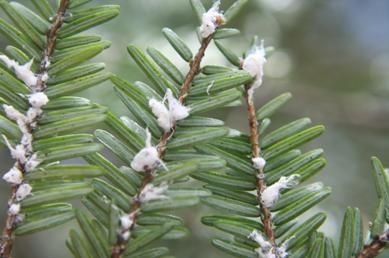Wooly Adelgid

The hemlock woolly adelgid is tiny, less than 1/16-inch (1.5-mm) long, and varies from dark reddish-brown to purplish-black in color. As it matures, it produces a covering of wool-like wax filaments to protect itself and its eggs from natural enemies and prevent them from drying out. This “wool” (ovisac) is most conspicuous when the adelgid is mature and laying eggs. Ovisacs can be readily observed from late fall to early summer on the underside of the outermost branch tips of hemlock trees.
The ovisacs of the winter generation contain up to 300 eggs, while the spring generation ovisacs contain between 20 and 75 eggs. When hatched, the fi rst instar nymphs, called crawlers, search for suitable feeding sites on the twigs at the base of hemlock needles. Once settled, the nymphs begin feeding on the young twig tissue and remain at that location throughout the remainder of their development. Unlike closely related insects that feed on nutrients in sap, the hemlock woolly adelgid feeds on stored starches. These starch reserves are critical to the tree’s growth and long-term survival.

